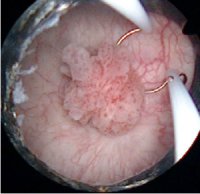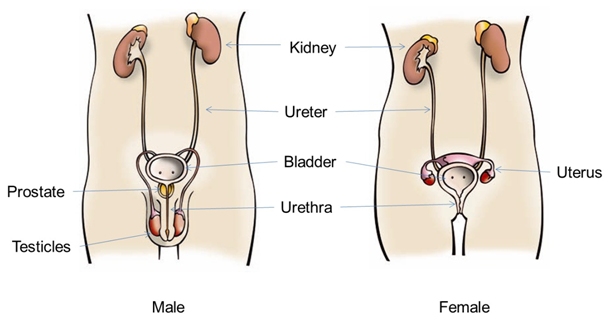
© copyright 2013-15, Disclaimer
Powered by Pelvitec

In bladder cancer the tumor arises on the inside of the bladder wall. These tumors are often formed like a mushroom (with a small stem).
Benign tumors also exist in the bladder, but they occur only in young adults. Bladder cancer normally shows itself because the fragile tissue often bleeds a bit, causing a redness of the urine.
Although this should be an alarming sign, a lot of people do not visit their doctor when the observe a red discoloration of the urine. Unfortunately the bleeding often stops by itself and the urine might not show anything wrong for several weeks or months - the tumor will however not stop growing.
While the cancer remains confined to the inside of the bladder wall, it can normally be removed surgically and the patient can be cured. However, it has a tendency to recur, so frequent controls are necessary for years.
Benign tumors also exist in the bladder, but they occur only in young adults. Bladder cancer normally shows itself because the fragile tissue often bleeds a bit, causing a redness of the urine.
Although this should be an alarming sign, a lot of people do not visit their doctor when the observe a red discoloration of the urine. Unfortunately the bleeding often stops by itself and the urine might not show anything wrong for several weeks or months - the tumor will however not stop growing.
While the cancer remains confined to the inside of the bladder wall, it can normally be removed surgically and the patient can be cured. However, it has a tendency to recur, so frequent controls are necessary for years.
If it is not treated in time, the cancer might start penetrating the bladder wall, and might also spread to other parts of the body, like the lymphnodes. This will make treatment more difficult.
The tissue on the inside of the bladder closely resembles the tissues found in the ureters and renal pelvis.
X-rays of these organs will therefore also be part of the frequent checkups once a bladder tumor has been found to make sure that no tumor will be missed.
The treatment of bladder cancer is very much depending on the size of the tumor and whether it is still confined to the inside of the bladder wall or not. The presence of tumor spread to other parts of the body also influences the choice of therapy. If the tumor is confined to the inside of the bladder wall, it can usually be removed by cystoscope through the urethra (TURT: TransUrethral Resection of Tumor); afterwards only a small scar will mark the spot. Frequent checkups by cystoscopic examination will be necessary to be able to detect and to remove recurrent tumor early in its development.
The tissue on the inside of the bladder closely resembles the tissues found in the ureters and renal pelvis.
X-rays of these organs will therefore also be part of the frequent checkups once a bladder tumor has been found to make sure that no tumor will be missed.
The treatment of bladder cancer is very much depending on the size of the tumor and whether it is still confined to the inside of the bladder wall or not. The presence of tumor spread to other parts of the body also influences the choice of therapy. If the tumor is confined to the inside of the bladder wall, it can usually be removed by cystoscope through the urethra (TURT: TransUrethral Resection of Tumor); afterwards only a small scar will mark the spot. Frequent checkups by cystoscopic examination will be necessary to be able to detect and to remove recurrent tumor early in its development.


If the tumor has grown into the bladder wall, it is generally impossible to remove it through the cystoscope.
In those cases, an operative procedure will be necessary to remove a part of the bladder containing the tumor. Often the bladder as a whole will need to be removed and the ureters will be connected to the skin (stoma) via a small isolated part of the small bowel. This type of operation is quite demanding on the general health of the patient and will only be done if he or she can take it. If not, radiotherapy can be an alternative.
In those cases, an operative procedure will be necessary to remove a part of the bladder containing the tumor. Often the bladder as a whole will need to be removed and the ureters will be connected to the skin (stoma) via a small isolated part of the small bowel. This type of operation is quite demanding on the general health of the patient and will only be done if he or she can take it. If not, radiotherapy can be an alternative.
Superficial tumor: no ingrowth of the tumor into the bladder wall
Muscle-invasive tumor: ingrowth into the bladder wall
Muscle-invasive tumor: ingrowth into the bladder wall
About Bladder cancer.
Cystoscopy: a urologist is checking the inside of the bladder.
Within 24 hours after the removal of the bladder tumor, you will get a bladder installation (rinsing of the bladder) with a special chemical agent in order to prevent frequent recurrences.
Bladder installations can be combined with an EMDA-treatment to improve the efficacy of the drug (chemical agent) installed into your bladder.
Bladder installations can be combined with an EMDA-treatment to improve the efficacy of the drug (chemical agent) installed into your bladder.

EMDA
Optimal treatment of superficial bladder tumours
Superficial tumors can be removed
the inside of the bladder
the inside of the bladder
Bron: www.urolog.nl
